
A plum is a fruit of some species in Prunus subg. Prunus. Dried plums are most often called prunes, though in the United States they may be just labeled as 'dried plums', especially during the 21st century.

The jackfruit is the fruit of jack treeArtocarpus heterophyllus, a species of tree in the fig, mulberry, and breadfruit family (Moraceae). The jackfruit is the largest tree fruit, reaching as much as 55 kg in weight, 90 cm in length, and 50 cm in diameter. A mature jackfruit tree produces some 200 fruits per year, with older trees bearing up to 500 fruits in a year. The jackfruit is a multiple fruit composed of hundreds to thousands of individual flowers, and the fleshy petals of the unripe fruit are eaten.

Persicaria odorata, with common names Vietnamese coriander, rau răm, laksa leaf, Vietnamese cilantro, phak phai, praew leaf, hot mint, Cambodian mint and Vietnamese mint, is an herb whose leaves are used in Southeast Asian and Northeast Indian cooking.

Pandanus is a genus of monocots with some 578 accepted species. They are palm-like, dioecious trees and shrubs native to the Old World tropics and subtropics. The greatest number of species are found in Madagascar and Malaysia. Common names include pandan, screw palm and screw pine. They are classified in the order Pandanales, family Pandanaceae.

Gnetum gnemon is a gymnosperm species of Gnetum, its native area spans from Mizoram and Assam in India down south through Malay Peninsula, Malay Archipelago and the Philippines in southeast Asia to the western Pacific islands. Common names include gnetum, joint fir, two leaf, melinjo, belinjo, bago, and tulip.
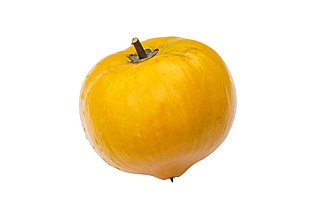
Pouteria campechiana is an evergreen tree native to, and cultivated in, southern Mexico, Belize, Guatemala, and El Salvador. It is cultivated in other countries, such as India, Costa Rica, Brazil, the United States, the Dominican Republic, Australia, Cambodia, Vietnam, Indonesia, Sri Lanka, Nigeria, and the Philippines. The edible part of the tree is its fruit, which is colloquially known as an egg fruit.
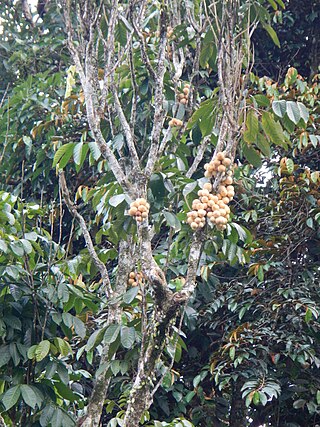
Lansium domesticum, commonly known as langsat or lanzones, is a species of tree in the family Meliaceae with commercially cultivated edible fruits. The species is native to Southeast Asia, from peninsular Thailand and Malaysia to Indonesia and the Philippines.

Spondias is a genus of flowering plants in the cashew family, Anacardiaceae. The genus consists of 17 described species, 7 of which are native to the Neotropics and about 10 are native to tropical Asia. They are commonly named hog plums, Spanish plums, libas in Bikol and in some cases golden apples for their brightly colored fruit which resemble an apple or small plum at a casual glance. They are only distantly related to apple and plum trees, however. A more unequivocal common name is mombins.

Arenga pinnata is an economically important feather palm native to tropical Asia, from eastern India east to Malaysia, Indonesia, and the Philippines in the east. Common names include sugar palm, areng palm, black sugar palm, and kaong palm, among other names.

Peranakan cuisine or Nyonya cuisine comes from the Peranakans, descendants of early Chinese migrants who settled in Penang, Malacca, Singapore and Indonesia, inter-marrying with local Malays. In Baba Malay, a female Peranakan is known as a nonya, and a male Peranakan is known as a baba. The cuisine combines Chinese, Malay, Javanese, South Indian, and other influences.
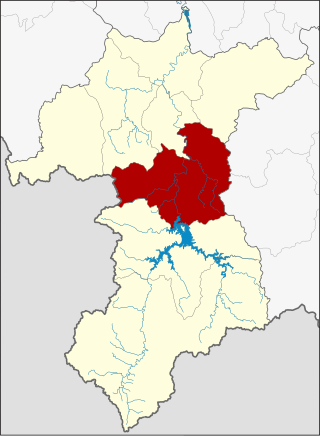
Bannang Sata is a district (amphoe) in the southern part of Yala province, southern Thailand. It is the site of the Bang Lang Dam and reservoir.

Spondias dulcis, known commonly as June plum, is a tropical tree, with edible fruit containing a fibrous pit. In the English-speaking Caribbean it is typically known as golden apple and elsewhere in the Caribbean as pommecythere or cythere. In Polynesia it is known as vī.
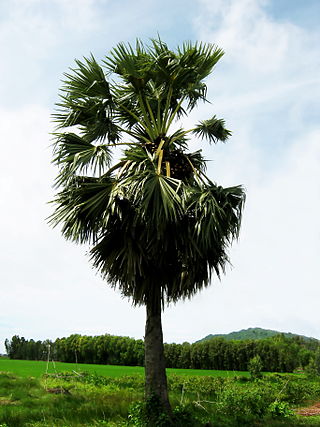
Borassus flabellifer, commonly known as doub palm, palmyra palm, tala or tal palm, toddy palm, lontar palm, wine palm, ထန်းပင် (htan-pin) or ice apple, is a fan palm native to South Asia and Southeast Asia. It is reportedly naturalized in Socotra and parts of China.
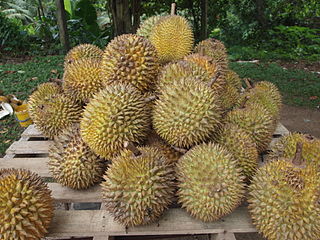
The durian is the edible fruit of several tree species belonging to the genus Durio. There are 30 recognized Durio species, at least nine of which produce edible fruit. Durio zibethinus, native to Borneo and Sumatra, is the only species available on the international market. It has over 300 named varieties in Thailand and 100 in Malaysia as of 1987. Other species are sold in their local regions.

Elaeocarpus bancroftii, commonly known as Kuranda quandong, Johnstone River almond, ebony heart, grey nut, or nut tree is a large rainforest tree in the family Elaeocarpaceae which is endemic to Queensland. It has coriaceous leaves, attractive white flowers and relatively large fruit containing an edible kernel.

Oroxylum indicum is a species of flowering plant of the monotypic genus Oroxylum in the family Bignoniaceae. It is commonly called Indian trumpet tree, oroxylum, Indian trumpet flower, broken bones, scythe tree or tree of Damocles. It can reach a height of 18 metres (59 ft). Various segments of the tree are used in traditional medicine.

Kundang or Pengkalan Kundang is an area in Gombak District, Selangor, Malaysia. Kundang is used to be agricultural village. But now, it is one of the modern villages in the state with its own highway, LATAR. Bandar Tasik Puteri, Pekan Kundang, Bandar Rawang is the nearest town from the village. Farming and related activities constitute the core economic drivers of this pastoral village. It comes under Selayang Parliament constituency, and falls into the jurisdiction of Majlis Perbandaran Selayang (MPS).

Spondias pinnata, sometimes also known as hog plum, is a species of tree with edible sour fruits. It is native to the Philippines and Indonesia, but has been widely naturalized in South Asia, Mainland Southeast Asia, Southern China, and the Solomon Islands. It belongs to the family Anacardiaceae. This species, among several others, has sometimes called the "wild mango" in other languages and was once placed in the genus Mangifera. It is found in lowlands and hill forests up to 1,200 m (3,900 ft).
Bouea oppositifolia, also known as plum mango, kundang, kundangan or remenia, is a species of flowering plant, a fruit tree in the mango family, that is native to Indochina and Southeast Asia.























